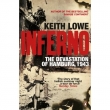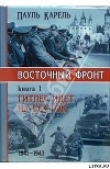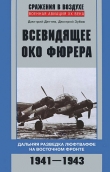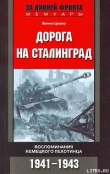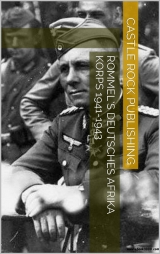
Текст книги "Rommel's Deutsches Afrika Korps 1941-1943"
Автор книги: Автор Неизвестен
Жанры:
История
,сообщить о нарушении
Текущая страница: 11 (всего у книги 19 страниц)
The area of the 8th Army's assault and its power surprised Stumme and Rommel, who flew back from Germany immediately news came through, realised that it was too late to alter the situation. By the fourth day of battle the southern sector had to be robbed of men to fill out the northern flank and by 26 October the number of tanks with 15th Panzer had shrunk to 39 and to 98 with the 21st Panzer Division. Being less involved in the fighting the Italian tank losses had been correspondingly lighter. These figures were further reduced and on 27 October the Africa Corps had only 114 runners and the Italians 206. The losses in armour to 8th Army had been 215 machines.
The crisis in supplies was renewed and in desperation Rommel signalled to Hitler that the Army after 10 days of hard fighting against an overwhelmingly numerically superior enemy was exhausted. Shortage of petrol would condemn the non-motorised units to annihilation and even the mobile units had insufficient fuel to take them any great distance. Rommel's message concluded with the bitter forecast that Hitler must be prepared for the total destruction of the Army in Africa. The German commander had telegraphed no less than the truth for the artillery had no fuel to tow the guns and the panzer strength of the Corps had sunk to 30 machines.
Hitler's reply was characteristic: 'The German people follow with me ... the men of the Italian and German unjts in their heroic battles ... Not one step back. Victory or death.' This sort of armchair strategy did not suit Rommel who needed freedom of action. With Hitler's reluctant permission to move back to the Fuka pass came the usual promises of future supplies, including the improved 7.5cm anti-tank gun and the new 8.8cm weapon; but no immediate help could be given and in the retreat to take up the Fuka positions there were more serious losses when Montgomery's tank regiments, impatient for revenge, overhauled and smashed the less speedy Pavia, Brescia, and Folgore Divisions, wreaking such havoc that XX Corps was reduced to one weak battalion without tanks and Ariete was completely destroyed as a fighting force.
On 1 November a new and temporary front was built at Sollum and the panzer divisions held, as usual, the open desert flank against 8th Army's thrusts out of the sand seas. At every defensive line along which the Axis armies tried to halt the British advance certain situations repeated themselves. Firstly, the mobile troops would restrain for as long as possible 8th Army's assaults and appeals would be made by Rommel for permission to evacuate the non-motorised units of the Italian Army. From Hitler or from Mussolini would then come the order to hold the stated line to the last, but then they would finally give the authority to ferry back the Italian infantry to a new line. Lastly, in this series of frustrations the panzers would cover this withdrawal and conduct another fighting retreat to the next position, at which the same sequence of events would be repeated.
Rommel knew, as OKW and Commando Supremo must have known, that if the Panzer Army was to survive it must avoid a war of attrition and stay a potent force, for now there was a new menace.
On 8 November Anglo-American divisions had landed in Algeria and were racing for Tunisia aiming to cut off the Axis armies in the desert. If their drive succeeded then Panzer Army Africa and its Italian allies would be trapped, although Axis forces had been rushed to the Tunisian bridgeheads and the situation though desperate did not seem to be quite hopeless.
But in the desert it was clear that the whole of Cyrenaica would have to be abandoned and Rommel put forward a plan to dig in and to hold what line he could while the main of the Army was evacuated back to the mainland. Hitler rejected this plan and proposed to reinforce the army in Africa, supplying it with every requirement, but on the condition that the line of the Marsa el Brega position be held as a base for future operations.
The movement into these new positions was carried out in heavy rain which halted Montgomery's advance. The new defence line was a disaster. The so-called strong points were often 5 miles apart and not mutually supporting. The whole front covered 110 miles, that is a greater depth than at Alamein, with only 30,000 mines to form a barrier and with the open flank guarded by one unreliable, native battalion. Thus, with a weaker line, with fewer troops, and his losses not made good, Rommel was expected to delay the British advance indefinitely. Panzer Army was weak in numbers.
From an establishment of 264 anti-tank guns there were only 12 with the troops, and only 35 of the establishment strength of 371 tanks, 16 armoured cars from a total of 60, and 12 howitzers instead of 60. The Italian divisions which had been rushed across from the mainland to replace that army's losses were without front line experience and were, therefore, nothing but a dead weight of useless mouths to feed. There was no ammunition reserve, only three days supply of fuel and the army had had no bread for a week.
In view of his weakness and so that 8th Army's blow which would come in during the middle of December would strike into a vacuum, Rommel withdrew from El Agheila back to Marsa el Brega and the point from which the Africa Corps had set out with such high hopes 18 months previously. The whole of Marmarica and Cyrenaica had been given up and there was neither a geographical obstacle nor the forces available to hold back the British advance for any great period of time. The Gabes line in Tunisia was the next and best possible natural barrier and in view of the Allied and Axis landings in that country, a withdrawal of the Panzer Army into that region could be made without infringeing French sensibilities.
Rommel demanded a withdrawal to Buerat as an interim measure only, presaging the anticipated move back to Gabes and pointed out that there would be no fuel for the portering of the Italian infantry at the height of the battle and that in such a retreat as he was proposing the speed of the slowest unit determined the pace of the whole. His force must remain mobile; there could be no question of being tied down to fight an attritive battle. It was imperative that the non-mobile infantry divisions be sent back to Buerat before the battle opened. A lost battle would mean not only the destruction of the army but that Tripolitania would be lost and the Axis' new bridgehead in Tunisia would be smashed. [17]
Commando Supremo and OKW ordered that the Marsa el Brega position be held to the last and Kesselring who flew to Libya asserted that any withdrawal to Buerat would encourage an Allied attack. To this Rommel bitterly replied that, whether his army was rolled over and destroyed in the Marsa el Brega or in the Buerat position was irrelevant, unless he had freedom of action he could do nothing to stop the Allies winning the war in Africa within the shortest possible time. The strength of the Africa Corps was reduced to 54 panzers, 18 armoured cars, and 66 anti-tank guns, his men were sleeping in the open in pouring rain in mid-winter, and the rations had been cut and cut again. German losses alone during the month of November had been 1122 killed and 3885 wounded. If the Panzer Army was to hold the positions demanded by OKW and the Commando Supremo then each German battalion would be holding a front of two miles and there would be no reserve. Rommel demanded the supplies which Hitler had said he would send and the Fiihrer promised them all again but demanded as his price that Tripoli would be held. Political necessity as well as military requirement demanded the maintenance of the largest possible bridgehead on the African coast.
It was clear that Hitler still saw the African theatre of operations as two separate battles whereas Rommel considered that his Panzer Army and 5th Panzer Army in Tunisia formed a single combat zone. In a conference with the Fiihrer Rommel repeated the advantages which a withdrawal to the Gabes line inside Tunisia would bring, whereas the only advantage of the Buerat line was that it gained time to allow the Gabes feature to be properly manned. Rommel's arguments were coldly logical and their conclusions inescapable. The withdrawal began even as 8th Army's carefully prepared advance began its forward movement. First the Italian infantry was evacuated and then in the bitter winter weather of 13 December the remaining panzers moved westward again. But once again the critical shortage of fuel held the panzers prisoner and they were threatened with encirclement by the swift-moving 7th Armoured Division. In the nick of time supply columns reached the armour and enabled the panzer regiments to fight their way through the British ring, battling now with the despair of a forlorn hope and with the bitter knowledge that their Supreme Commander Hitler had dismissed their efforts and had ignored their urgent needs.
Without fuel and lacking the supplies which the Fiihrer had promised, Rommel could not hope to hold the Buerat position and once that line had been abandoned then Tripolitania would have to be evacuated if the Army was to be saved. In desperation the German commander asked for permission to march back to Gabes and received Mussolini's bombastic reply 'Buerat will be held to the last'. With only 38 panzers in action, a further 12 in the Buerat line, and 10 without fuel in Tripoli, there was little that the Panzer Army could do to fight a defensive battle. On 29 December the 8th Army stood ready to assault the Axis positions. A crisis conference attended by the senior German and Italian commanders from the mainland demanded that Mussolini's orders be respected but Rommel pointed out that the length of time that the Buerat position could be held depended less upon him and his Army than upon the British and theirs. There were 30,000 Italian troops who were a dead-weight and their transport from defence line to defence line used petrol which the panzers needed. Of the daily minimum requirement of 400 tons only an average of 152 tons arrived. The panzer arm was operating with only 20 per cent of its establishment and the infantry was 50 per cent below its requirements. There were two lines of defence along which minimal resistance could be offered: Homs-Misurata and the final perimeter around Tripoli. This was the last chance to save the army from destruction. The evacuation from Buerat began on 3 January; once again Rommel's logic had proved to be irrefutable.
In Tunisia the dangerous military situation compelled von Arnim, commanding 5th Panzer Army, to ask for one of Rommel's infantry divisions to be withdrawn from the line and sent to occupy Sfax against any Allied move from the Kasserine sector. Rommel appealed to Hitler against this demand and was ordered to send 21st Panzer but was instructed to withdraw the tanks from that unit and hand them over to 15th Panzer Division. That division withdrew and as the Axis forces pulled back from the Buerat position on 15 January they could see from the Tarhuna heights the fires which marked where 18 tanks of Centauro Division had been blown up to prevent them falling into British hands.
Other pillars of smoke indicated where lorries for which there was no petrol had been destroyed. The German observers of that sad scene would also have seen spread before and below them a panorama of the whole of 8th Army's armoured might as it moved towards the Tarhuna pass. Against the full weight which Montgomery could commit to battle the Panzer Army Africa could send in only 23 panzers and 16 Italian tanks. Then, as this last remnant battled with the British, a telegram was received from Mussolini complaining that the Buerat position had been abandoned prematurely.
From the direction of Montgomery's thrust Rommel appreciated that the British intention was to bypass Tripoli and then to wheel inwards. Thus the Germans would be pinned with their backs to the sea. They would be cut off from Tunisia and the whole of the southern Tunisian flank would stand open to 8th Army's direct assault. He signed the order to evacuate Tripoli with a heavy heart for he realised that this meant to his Italian allies the end of the empire but Rommel knew that if he was to save the Panzer Army then there was no other decision he could make.
With the evacuation of Tripoli and the withdrawal into Tunisia the desert campaign came to an end but in the northern bridgehead Rommel still hoped that there might be more hopeful prospects and that a position could be held from which, with the promised reinforcements and fresh supplies there might one day again burst forth from the confines of the Tunisian bridgehead a reborn Panzer Army Africa.
Tunisia Campaign 1942
During the late summer of 1942 the attention of the western Allies as well as that of the OKW was directed towards the western Mediterranean in general and upon the North African colonies of France in particular.
The Anglo-Saxons were concerned to relieve pressure upon the Russians by mounting a so-called Second Front but the British, aware that Allied forces were at that time too weak to undertake successfully a landing and a campaign in north-west Europe, suggested other alternatives. In a memorandum President Roosevelt offered his military chief of staff three options. The top priority was given to the idea of a landing in French North Africa and by a rapid advance eastwards to cut off the enemy armies in the desert. The second option was for the Americans to link up with the British 8th Army in Tripoli and by joint action defeat Rommel and his Italian allies. Finally there was the option of landing in France and then establishing in the southern part of that country a bridgehead out of which, at some future date, reinforced Allied armies would burst in a campaign of liberation. But whatever the choice Roosevelt's order was that an offensive operation on land, and in the European theatre of operations, had to be launched during 1942. As Commander-in-Chief he
committed the United States to the first option. Reluctantly the American chiefs of staff agreed; French North Africa was to be invaded.
That this undertaking, code-named Operation Torch, would entail an armed assault upon the territory of a neutral nation was dismissed. The fact that the Axis powers had so completely respected French neutrality, that there was no German or Italian soldier stationed in any of the French possessions, was considered a positive advantage, for thus there would be no opposition to overcome on the road to Tunis. Further to smooth the path of the invaders secret service agents had contacted French officers and civilians loyal to the Allied cause and on the basis of their reports it was anticipated that resistance to the attack would be minimal. It was further expected that both the native population and the French colonial settlers would welcome the Allied forces as liberators, although as liberators from what or from whom was never made clear.
General Eisenhower was appointed to command this first offensive undertaking by the American Army in the western hemisphere and the choice of an American commander was intended to convey to the French in North Africa who may have had anti-British feelings, the totally false impression that Operation Torch was an entirely United States operation.
There were four strategic areas which the western Allies could have chosen as target areas but only two had the qualifications necessary for the success of a major naval and military operation. Of these two we can ignore the landings in western Algeria. We are concerned only with the assault upon eastern Algeria, and upon the Allied formations which debarked upon the shores of that region. The troops of that Anglo-American force were directed to thrust towards Tunisia and to seize the principal towns of Tunis and Bizerta. The capture of these major ports as well as that of less important harbours would bring an Allied army into position behind the Axis troops, at that time fighting in Tripoli, and thus between those troops and the ports from which they might make their escape to the mainland of Europe. The success of Operation Torch would make the question of whether the Axis or the Allies won the war in Africa academic. All that was needed, so it seemed to the Allied planners, was to race for Tunis sweeping aside any weak resistance from the Germans or Italians who might be encountered on the way.
Adolf Hitler, reviewing the strategical situation from his headquarters, came to the conclusion that if there was to be an Allied landing then this would take place either on the islands of Sardinia or Corsica, or possibly in southern France. The Fiihrer excluded North Africa completely from the possible targets for a sea-borne assault. German naval headquarters in the Mediterranean was not so confident, and, anticipating Allied landings, had drawn up plans for U-boat action against these. By a coincidence the Axis planners, as early as July 1942, chose as the most likely debarkation points those areas along the French North African shore which the Allied strategists themselves had selected. As U-boat strength in Italian waters was not enough to mount a whole series of widespread assaults against the ships of the Allied armada and was too weak to cover all possible target areas, a pair of intercept patrol lines was charted in the waters of the western half of the Mediterranean sea across which the Allied ships would have to sail to their landing areas and along which they could be attacked.
Reports reaching German naval headquarters which spoke of a concentration of shipping in Gibraltar were misinterpreted by Axis supreme commands, as was later intelligence of this build-up as a major convoy to Malta. But then reports reaching Rome brought graver and reliable news so that by 4 November it was clear that the naval preparations which the Allies were making presaged an invasion of North Africa. The evidence convinced both Mussolini and Kesselring, the German Supreme Commander South, but Hitler still clung to his beliefs of a landing upon Corsica or Sardinia, although on 6 November he did send a signal to the senior German naval officer in the Italian waters telling him that the fate of the army in Africa depended upon the destruction of the Gibraltar convoy and demanding from the U-boat crews relentless and victorious action.
During the night of 6/7 November every submarine which could be pressed into service headed westwards to the patrol lines, on an intercept course with the Allied convoy of 190 ships which was now sailing, completely blacked out, through the waters of the Mediterranean.
At 04.00hrs on the morning of 8 November the Allied assault opened at selected points along the Algerian coast and continued throughout the day. In some areas there was little or no opposition but in others there were French naval forays of such ferocity that the intervention of American heavy naval units was required to overcome them. By the morning of the following day an Allied army was ashore and was streaming along the roads towards Tunisia.
Hitler received the news of the invasion while at a wayside railway station en route to Munich and his immediate decision was to hold Tunisia. There would be no retreat. As a first reaction he offered air support to help Vichy France (the French under Petain) in its defence of the North African possession and under cover of this offer Luftwaffe units began to move into Tunisia during the night of 9 November. Meanwhile a telephone conversation between Hitler and Kesselring had taken place.
To answer the question on the number and type of troops which could be rushed without delay to bar the Allied advance, Kesselring could reply that only two battalions of Lieutenant-Colonel Koch's 5th Parachute Regiment and his own headquarters defence battalion were immediately available. 'Fling in everything you can', was the Führer's dramatic command. The orders for their despatch went out to the units on standby and then Kesselring's staff officers swung into a long-planned routine; the transport of a complete division from the strategic reserve in Sicily. But the German Supreme Command did not have the same view of Mediterranean strategy as Kesselring and, determined not to infringe French neutrality, refused to allow this stand-by division to be deployed to Tunisia. Not until 24 hours after the first Allied landings had taken place did Kesselring receive from Hitler the powers he needed, but even then the French authorities were handled with extreme delicacy. Permission was sought and obtained from Marshal Petain allowing the German troops to move into Tunisia.
Then began what has been described by some German military commentators as 'the poor man's war'; for with only a small force of troops, one wing of fighter aircraft, and a general without a staff, the German forces which had begun to land in Tunisia were ordered to stop the advance of the onrushing Allied troops by forming a bridgehead with a short, defensible perimeter and situated at an adequate distance from the main ports of Tunis and Bizerta.
Either as a bluff or as a piece of absolute cynicism Kesselring commented that a general should be sent to Tunisia – one with the wide red stripes of the general staff on his breeches – for his presence would be reported back to Eisenhower via the intelligence network, and who on the Allied side would believe that a German general could be sent into the field without the necessary troops for him to command. On the evening of 8 November, General Nehring was recalled from convalescence and ordered back to Africa. But not to his old command, for in Rome fresh orders awaited him. He was to take charge of operations in the Tunisian area and was quickly briefed on the task he had been given.
The terrain over which the battles of the next six months were to be fought was hilly, almost mountainous, particularly in the west and in the northwestern frontier area where it bordered Algeria. To the east and to the south the ground became more flat, leading to a plain, and in some areas there was marsh. In the valleys between the western hills and on the plain there was extensive cultivation but the hills themselves were bleak and covered with scrub. The lie of the land favoured the defence for the high ground ran in a general north-easterly direction and the defenders would withdraw from peak to peak while denying the valley roads to an Allied advance. This was particularly the case on the eastern side of the country where the Mediterranean formed one flank which could not be turned. On this coastal side of Tunisia the mountains reached, at some places, almost to the sea and thus formed narrow gaps across which the Axis armies formed defensive lines.
The Tunisian road network was poor both in number and durability and only the few macadamised highways could be used in the rainy period which extended through the winter and into spring, by unhappy coincidence, the two seasons of the campaign. In the winter the principals were torrential rain creating mud and destroying the secondary roads, and low cloud, which curtailed combat flying, and bitter cold which could not be escaped by the infantry since the hills in which they had to live were generally devoid of man-made or even natural cover. By the middle of March the returning warm weather dried out the ground allowing wheeled movement off roads. There was much horticulture, with orchards of olive trees, cork forests, wheat and fruit growing. The cactus bush was every where and was used widely to form hedges, particularly around the larger, French-owned farms. When the Germans took over these buildings and prepared them for defence the cactus formed a natural type of barbed wire entanglement and helped to turn these farms into fortresses, almost unassailable by infantry and armour.
The few strategic and all-weather roads extended from the capital or from the principal port of Bizerta westwards towards Algeria, south-westwards to Kairouan, or southwards to Tripolitania. The junctions of roads were of strategic importance and whoever controlled these and the towns which had grown up around them dictated the course of the fighting. As this narrative of the events which took place in Tunisia between November 1942 and May 1943 unfolds then the names of those towns and villages which were important to the campaign will become familiar: Beja, Mateur, Tebourba. Kasserine, Enfidaville, and Medjez el Bab. It is this last named place which was the key to the whole campaign and its capture by the British opened the great offensive which finally brought the war in Africa to a close.
Roads, then, and particularly road junctions were strategically important but it was not necessary to have troops on the highway itself; possession of high ground overlooking the road produced the same result. Thus each side fought to attain or to eject the other side from the mountains or the valley road. [18]

The population of Tunisia was predominantly Arab with a large number of French inhabitants, both military and civilian, and a lesser but still sizeable Italian contingent. These latter hoped for an Axis victory and many were called up to serve in locally raised Italian regiments. The French were divided into those who supported the western Allies and those whose sympathies lay with the Government of Marshal Petain. The Arabs had no strong feelings and were capable of betraying British soldiers to the Germans and German positions to the British with complete impartiality.
The Tunisian campaign can be seen to fall into three distinctive phases. In the first of these, lasting from the Allied landings to the end of December, there was a race to obtain tactically and strategically important positions. During this first period the descents upon Tunisia by both sides were followed by a thrust made by a force, mainly British in content, and aimed at the capture of Tunis and Bizerta. A German counter-attack drove back the weak Allied force and a line was formed along which there was for some time a stalemate.
The second phase began with a resumption of the German offensive aiming to expand the bridgehead area. These attacks lasted until April and within this period there was the major assault upon the American forces forming the right flank of the Allied army in Tunisia. When the United States' forces drove back Rommel's panzer thrust they joined hands with the British 8th Army which had entered Tunisia from the south and thus formed a noose around the Axis armies.
The third phase saw the build-up of strong Allied forces, the tightening of the noose, the switching of some 8th Army Divisions to the 1st Army, and the final thrust from Medjez el Bab which smashed the Germans and their Italian allies.
When compared to the battles of the Titans which were being fought in Russia the events in Tunisia seem of small proportion. The whole Axis force which fought there was not even half the size of any one of the army groups fighting on the eastern front, but it was a campaign that was significant for it showed that the Anglo-Saxon Allies had the capability and the knowledge successfully to mount a major sea-borne invasion. This fact was not lost upon the German High Command who as early as February 1943 telexed an Abwehr [19] appreciation that further sea-borne landings could be expected to take place during March in the Mediterranean area and aimed either at Sicily, Crete, Sardinia, or Corsica.
The Tunisian campaign also 'blooded' the green Americans enabling both the leaders and the led to learn the business of war at combat and at command levels. These lessons they then applied to the fighting which was carried out in Sicily and in Italy where the terrain was much the same as Tunisia. As a military parallel the war in Tunisia was, by accident, to the Allies the same sort of testing ground that Spain had been for the Axis forces.
If the Allies learned much to their future advantage as a result of the fighting in Tunisia then the German and Italian troops were to learn the bitter lesson of their vulnerability to Allied air power. By early spring this superiority had driven the Luftwaffe from the skies which it had dominated from the earliest days of the fighting and left, naked to the American and British air attacks, the transport aircraft lumbering slowly through the skies above the Mediterranean and the Axis merchant ships steaming their way through its waters. Both ran an Allied gauntlet and suffered terrible losses. It has been calculated that at the bottom of the sea lie more than twice as many tanks as the desert and Tunisian armies ever received.
Other than the experience of the loss of air cover the fighting in Tunisia provided no new experience for the Germans. Their flexibility in the matter of battle groups, their ability to improvise, the exploitation of time and means to overcome shortages and difficulties were no new phenomena. Only at highest command level was there hesitation and lack of direction. At medium and junior level, as well as at that of the ordinary soldier there was a determination to do the job well, and in this they succeeded.
In a campaign which lasted six months it would not be possible to describe in so few words as this book contains each or every major action. Some are more important or interesting than others and it is these which have been selected to represent the whole. The period covering the landings, the thrust and the riposte leading up to the battle of Longstop Hill in December 1942, is the first to be described. Then follows an account of the fighting in which the Axis forces tried to expand their bridgehead during which period there occurred the action by 10th Panzer Division at Sidi Sou Zid which led to the battle of Kasserine Pass.


